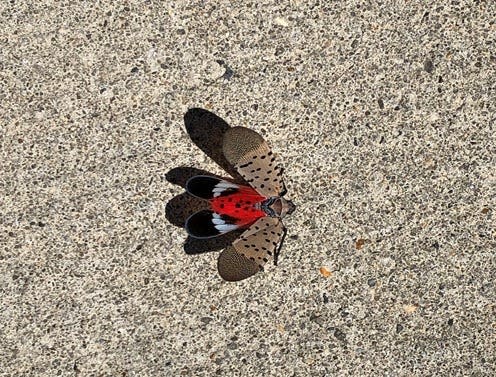As summer approaches, another season of stomping spotted lanternflies seems inevitable.
For the last few summers, spotted lanternflies have been invading communities across the country, especially in states like New York, New Jersey, Pennsylvania, Delaware and Maryland.
These brightly-colored bugs have been wreaking havoc on trees and other plants since their first appearance in Pennsylvania in 2014. But starting in 2020, their population has boomed in the Lower Hudson Valley and beyond.

According to the New York State Department of Conservation, the invasive species tends to feed on maple, walnut and fruit trees, as well as grapevines, a major market for New York state.
Since these creatures are a threat to local crops, the U.S. Fish and Wildlife Service has called on residents to stomp, scrape and vacuum spotted lanternflies wherever they see them to help eradicate their spread. The NYSDEC said New York’s apple and grape market makes over $350 million every year and has seen some negative impacts from the infestation.
When does spotted lanternfly season begin?
According to the DEC, adult spotted lanterflies begin to appear in July and are approximately 1 inch long and a half-inch wide at rest.
Newly hatched spotted lanternflies, or nymphs, can be seen as early as April and until July. They are black with white spots before they turn red. The red nymphs can be seen from July to September.
What do they look like?
Nymphs emerge in the spring, typically around April and May, and appear black with white spots. They will turn red before transitioning into the adults that have become a familiar sight to Lower Hudson Valley residents, with muted gray and red wings, black spots and bright red under their wings.
In the fall, adult insects lay 1-inch long eggs in clusters on tree trunks, cars, rocks and almost any other flat surface. They appear smooth and brown with a waxy coating when they are first laid. Older eggs are a deeper brown and scaly.
The DEC said an infestation is probable if sap is seen oozing from open wounds on tree trunks. This liquid waste, called “honeydew,” tends to attract black, sooty mold and could interfere with plant photosynthesis and outdoor fabrics and clothes.
How to get rid of them
NYSDEC and the USDA encourage residents to kill lanternflies on site, whether that’s stomping adults and nymphs, scraping and squashing eggs from tree trunks or cars and even vacuuming them.
The movement of goods between affected states also slows in the summer to prevent a mass spread and migration. Putnam, Rockland and Westchester counties have been identified by the NYSDEC as “protective zones,” allowing the organization to survey and manage the infestations.
Westchester County invested in 10 high-powered vacuums last summer to loan to local communities if residents find an infestation in their neighborhood. Forms for the vacuums can be found here, but should only be filled out by municipal employees,
Check your belongings before traveling to make sure the insects or eggs have not attached themselves to your objects. Egg masses can be killed by scraping them into a bucket of hot, soapy water or a jar of hand sanitizer.
The New York State Department of Agriculture and Markets said any resident who notices an infestation or sees an egg mass in their area should take a picture and sent it to spottedlanternfly@agriculture.ny.gov and include the location, such as zip code, street address or identifiable GPS landmarks.
This article originally appeared on Rockland/Westchester Journal News: Spotted lanternfly season in NY starts in July: What to know
Signup bonus from




